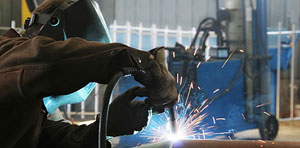Sheet Metal Engineer
Tasks & duties

Sheet metal engineers may do some or all of the following:
-
examine drawings and other instructions for the job
-
draw the pattern on the sheet metal and cut it out
-
drill and punch holes in the metal for screws, bolts or rivets
-
fold, form and shape the metal
-
join the metal pieces together
-
weld the seams of the metal
-
polish the finished article
-
check the quality of the finished product
Skills & knowledge
Sheet metal engineers need to have:

-
knowledge of metals and their properties
-
knowledge of how to use and care for their equipment
-
understanding of safety procedures
-
technical skills for drawing and interpreting plans
-
welding skills
-
maths skills for making calculations and working out formulae
Entry requirements
To become a sheet metal engineer you need to complete an apprenticeship and gain a National Certificate in Engineering (Fabrication) Level 4, specialising in light fabrication. For further information about apprenticeships contact Tools4Work.
Some employers may prefer that their apprentices are at least 16 years old. A driver's licence may also be useful.
Secondary education
There are no specific secondary education requirements. However, School Certificate or NCEA equivalent maths, technical drawing and workshop technology are useful.
Tertiary education
A pre-apprenticeship course may be useful for gaining a sheet metal engineering apprenticeship.
Training on the job
Sheet metal engineers gain most skills on the job. They can gain further qualifications through workplace assessments run by training providers.
Useful experience
Useful experience for Sheet metal engineers includes welding work or any jobs working with metals and tools. Experience working in an engineering workshop or jobs that involve heavy lifting may also be useful.
Related courses
Mechanical Engineering
Sheetmetal Working
For more information, please refer to Career Services.
Sponsors include
Document Actions
